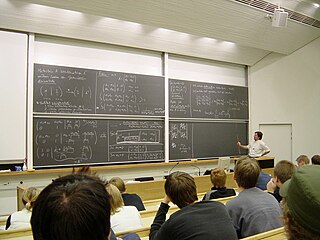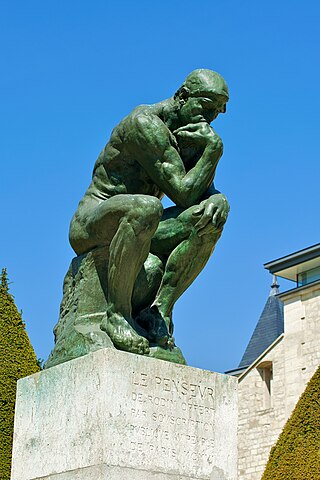
Educational psychology is the branch of psychology concerned with the scientific study of human learning. The study of learning processes, from both cognitive and behavioral perspectives, allows researchers to understand individual differences in intelligence, cognitive development, affect, motivation, self-regulation, and self-concept, as well as their role in learning. The field of educational psychology relies heavily on quantitative methods, including testing and measurement, to enhance educational activities related to instructional design, classroom management, and assessment, which serve to facilitate learning processes in various educational settings across the lifespan.

Rote learning is a memorization technique based on repetition. The method rests on the premise that the recall of repeated material becomes faster the more one repeats it. Some of the alternatives to rote learning include meaningful learning, associative learning, spaced repetition and active learning.

How to Solve It (1945) is a small volume by mathematician George Pólya describing methods of problem solving.

In contemporary education, mathematics education—known in Europe as the didactics or pedagogy of mathematics—is the practice of teaching, learning, and carrying out scholarly research into the transfer of mathematical knowledge.
Situated learning is a theory that explains an individual's acquisition of professional skills and includes research on apprenticeship into how legitimate peripheral participation leads to membership in a community of practice. Situated learning "takes as its focus the relationship between learning and the social situation in which it occurs".

Constructivism is a theory in education which posits that individuals or learners do not acquire knowledge and understanding by passively perceiving it within a direct process of knowledge transmission, rather they construct new understandings and knowledge through experience and social discourse, integrating new information with what they already know. For children, this includes knowledge gained prior to entering school. It is associated with various philosophical positions, particularly in epistemology as well as ontology, politics, and ethics. The origin of the theory is also linked to Swiss developmental psychologist Jean Piaget's theory of cognitive development.
Principles and Standards for School Mathematics (PSSM) are guidelines produced by the National Council of Teachers of Mathematics (NCTM) in 2000, setting forth recommendations for mathematics educators. They form a national vision for preschool through twelfth grade mathematics education in the US and Canada. It is the primary model for standards-based mathematics.
Reading comprehension is the ability to process written text, understand its meaning, and to integrate with what the reader already knows. Reading comprehension relies on two abilities that are connected to each other: word reading and language comprehension. Comprehension specifically is a "creative, multifaceted process" dependent upon four language skills: phonology, syntax, semantics, and pragmatics.
The Secondary School Admission Test (SSAT) is an admission test administered by The Enrollment Management Association in the United States to students in grades 3–11 to provide a standardized measure that will help professionals in independent or private elementary, middle, and high schools to make decisions regarding student test taking.

The following outline is provided as an overview of and topical guide to thought (thinking):
Singapore math is a teaching method based on the national mathematics curriculum used for first through sixth grade in Singaporean schools. The term was coined in the United States to describe an approach originally developed in Singapore to teach students to learn and master fewer mathematical concepts at greater detail as well as having them learn these concepts using a three-step learning process: concrete, pictorial, and abstract. In the concrete step, students engage in hands-on learning experiences using physical objects which can be everyday items such as paper clips, toy blocks or math manipulates such as counting bears, link cubes and fraction discs. This is followed by drawing pictorial representations of mathematical concepts. Students then solve mathematical problems in an abstract way by using numbers and symbols.
Reciprocal teaching is an instructional activity that takes the form of a dialogue between teachers and students regarding segments of text for the purpose of constructing the meaning of text. Reciprocal teaching is a reading technique which is thought to promote students' reading comprehension. A reciprocal approach provides students with four specific reading strategies that are actively and consciously used to support comprehension: Questioning, Clarifying, Summarizing, and Predicting. Palincsar (1986) believes the purpose of reciprocal teaching is to facilitate a group effort between teacher and students as well as among students in the task of bringing meaning to the text.
Reciprocal teaching is best represented as a dialogue between teachers and students in which participants take turns assuming the role of teacher. -Annemarie Sullivan Palincsar
The worked-example effect is a learning effect predicted by cognitive load theory. Specifically, it refers to improved learning observed when worked examples are used as part of instruction, compared to other instructional techniques such as problem-solving and discovery learning. According to Sweller: "The worked example effect is the best known and most widely studied of the cognitive load effects".

The eureka effect refers to the common human experience of suddenly understanding a previously incomprehensible problem or concept. Some research describes the Aha! effect as a memory advantage, but conflicting results exist as to where exactly it occurs in the brain, and it is difficult to predict under what circumstances one can predict an Aha! moment.

Neo-Piagetian theories of cognitive development criticize and build upon Jean Piaget's theory of cognitive development.
In mathematics education, a representation is a way of encoding an idea or a relationship, and can be both internal and external. Thus multiple representations are ways to symbolize, to describe and to refer to the same mathematical entity. They are used to understand, to develop, and to communicate different mathematical features of the same object or operation, as well as connections between different properties. Multiple representations include graphs and diagrams, tables and grids, formulas, symbols, words, gestures, software code, videos, concrete models, physical and virtual manipulatives, pictures, and sounds. Representations are thinking tools for doing mathematics.
Spatial intelligence is an area in the theory of multiple intelligences that deals with spatial judgment and the ability to visualize with the mind's eye. It is defined by Howard Gardner as a human computational capacity that provides the ability or mental skill to solve spatial problems of navigation, visualization of objects from different angles and space, faces or scenes recognition, or to notice fine details. Gardner further explains that Spatial Intelligence could be more effective to solve problems in areas related to realistic, thing-oriented, and investigative occupations. This capability is a brain skill that is also found in people with visual impairment. As researched by Gardner, a blind person can recognize shapes in a non-visual way. The spatial reasoning of the blind person allows them to translate tactile sensations into mental calculations of length and visualizations of form.
Graph literacy is the ability to understand information that presented graphically, which are including general knowledge about how to extract information and make inferences from different graphical formats. Although related, graph literacy is distinct from other forms of literacy in the sense that it relates more specifically to one's ability to obtain meaning from information presented graphically. It can include the storage of mental representations in long-term memory, knowledge about the properties of different types of formats, and procedures to interpret them. However, similar to other types of literacy, higher graph literacy is associated with higher education levels and suggests that developing the skills required to interpret graphical information requires knowledge that is acquired through formal education and experience.

Embodied design grows from the idea of embodied cognition: that the actions of the body can play a role in the development of thought and ideas. Embodied design brings mathematics to life; studying the effects of the body on the mind, researchers learn how to design objects and activities for learning. Embodiment is an aspect of pattern recognition in all fields of human endeavor.

Spatial ability or visuo-spatial ability is the capacity to understand, reason, and remember the visual and spatial relations among objects or space.









